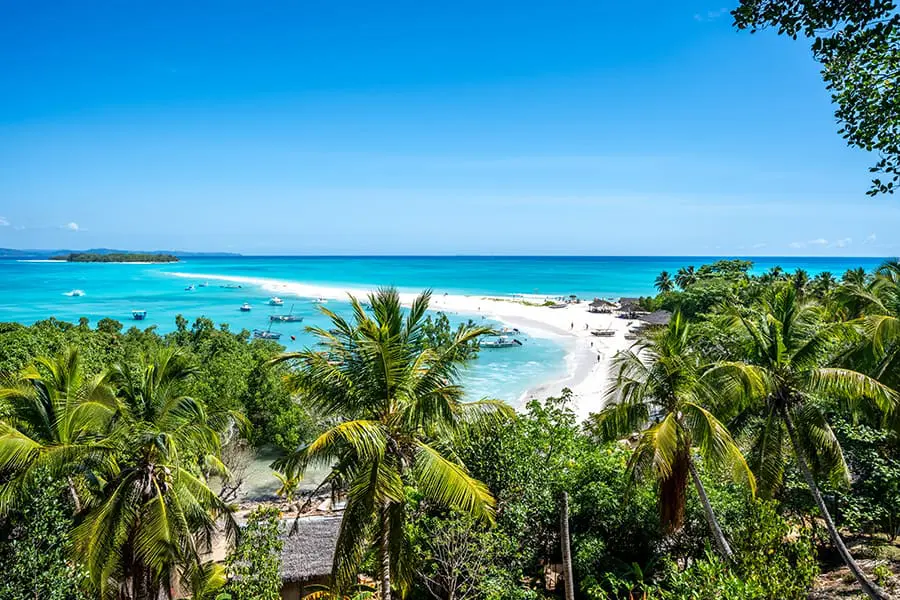Language
- English
- Español
Currency
- AUD Australian Dollar
- CAD Canadian Dollar
- EUR Euro
- GBP Pound Sterling
- USD US Dollar
- ZAR Rand

travel advice
The currency in Madagascar is the Malagasy ariary but almost all tourist-related costs and fees are contracted in euros. Take euros in cash to pay for sundry personal items not covered by your all-inclusive itinerary.
It is also best not to rely on credit cards as they are not accepted widely at all.
As in customary in Africa, tipping is voluntary in return for good service or assistance. It is usual to tip drivers, servers, skippers and their crew, and guides. It is not necessary to tip pilots. Gratuities should be in euros, if possible.

Madagascar has a classic southern hemisphere seasonal pattern: it is usually hot and rainy between about November and April (summer), and colder and drier between about May and October (winter).
January is generally the hottest month with an average temperature of 22°C / 72°F while July is the coldest at about 15°C / 59°F. December is the rainiest month with an average of 310mm / 12in of precipitation.
The climate is determined by the dominant south-eastern trade winds that originate in the Indian Ocean anti-cyclone.
Check out our Month-by-Month Guide for Travelling to Madagascar
Tourism is not well developed in Madagascar so it is important to pack thoughtfully as you will be unlikely to be able to easily buy items you forget once you leave Antananarivo and start to explore different parts of Madagascar.
Essentials include:
Madagascar does not have a highly developed tourism industry and most citizens are not used to tourists in their town or villages. It is very important to be mindful of this and show respect to people by:
There are direct flights into Antananarivo from Johannesburg in South Africa, Istanbul in Turkey, Addis Ababa in Ethiopia and Paris in France. You can easily combine a Southern African safari with time in Madagascar.
Madagascar is not a self-drive destination. Your Africa Safari Expert will put together a complete itinerary with all drivers and transfers included so you really enjoy your time on the island. Most journeys start in Antananarivo and go onto to Nosy Be in the north but we can create a tailor-made holiday based exactly on your interests, whether they are birding, hiking, diving or photography.
Because Madagascar is so vast, journeys will generally encompass flying and road transfers in 4x4s or ‘taxi-be’ as mini-busses are known on the island. Flights will all connect in Tana.
All visitors pay for a visa (in euros or US dollars) regardless of your citizenship. Please contact your nearest Malagasy consulate for the latest fees and applications. The short-term tourist visa will allow you 30 days' entry into the country.
Your passport must be valid for six months after your day of entry.
The history of Madagascar is as diverse as its landscapes, fauna and flora. It was originally part of the super-continent Gondwana; when it broke away from the mainland, the surviving species evolved into the endemic ones found today because they were cut off from outside influences and predators.
Although it is only about 400 kilometres or 250 miles from the African mainland, it has a wealth of other influences. The Mozambican Channel is very treacherous but other settlers may have arrived over the Indian Ocean from Indonesia, the Philippines and India, bringing rice with them. The Chinese and French also landed on Madagascar and, of course, the island's history includes African slavery and British colonialism.
Today there are at least 18 ethnicities – many with their own dialects. Most of the island is given over to agriculture but tourism, logging and mining are also making inroads (at least half the world's sapphires are said to originate from Madagascar).
The population is estimated at 20 million people and over 80 percent of them speak Malagasy. A small portion speak French while even fewer speak or are literate in English (this is why a Malagasy-speaking driver-guide is essential for your visit).
The culture is an enticing mix of African, South-East Asian, French, British and Chinese influences. Traditional clothing, houses and cuisine all have echoes of other world cultures, giving Madagascar an exotic accessibility.
The most iconic species that are most closely associated with Madagascar are, of course, lemurs. With their large eyes, acrobatic behaviour and multi-hued coats, lemurs are a type of primate that are distinct from apes and monkeys. They are the island's biggest attraction and the more travellers undertaking safaris to see them, the better their precious habitats will be protected. Lemurs are found across the country so it's worth combining two different areas to see as many types as possible.
Because it faces directly onto the Indian Ocean, the east coast is the wettest and lushest part of Madagascar and is covered by protected rainforest national parks. If you want to see lemurs, be sure to include this area in your itinerary. Head to Sainte Marie Island for seasonal whale watching. It is the most affected by the annual cyclone season (generally over December and January) so bear this in mind.
Directly opposite, on the west coast, you find a much more arid landscape that borders on semi-desert in some areas of the south-west. This drier climate is perfect for the growth of Africa's biggest tree – the baobab – and the world-famous Avenue of the Baobabs is found here.
Chat with someone who’s been there. Get in touch with one of our Africa Travel Experts to help tailor-make a trip to Madagascar that’s right for you.
Help Me Plan